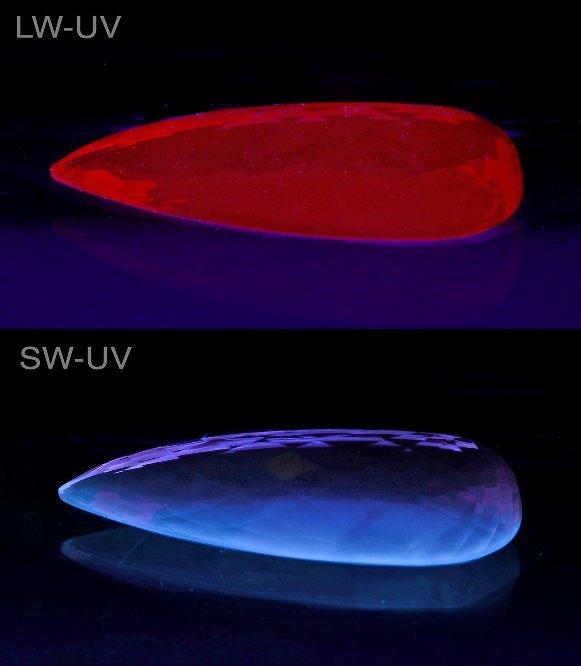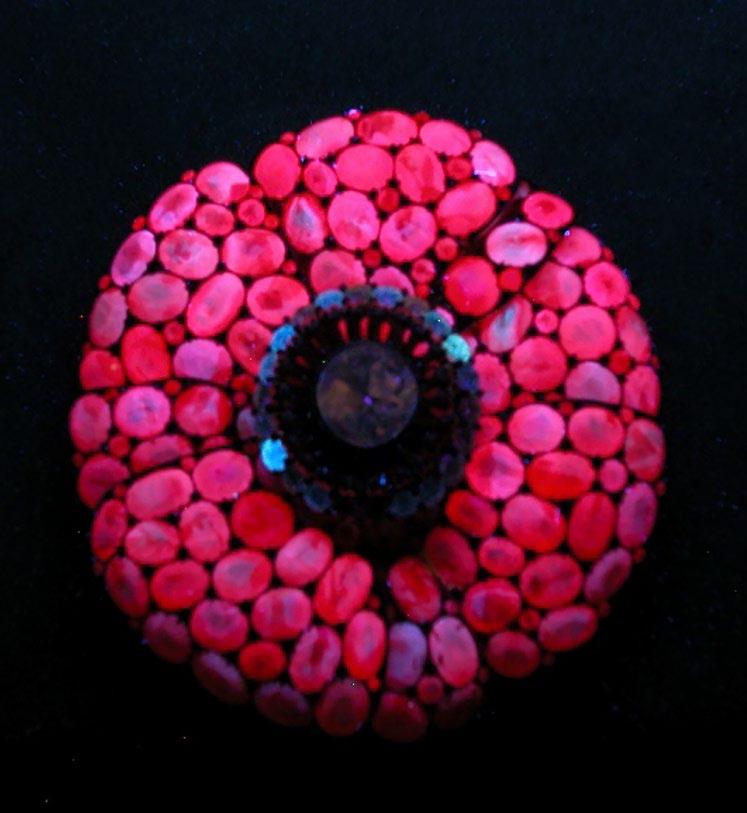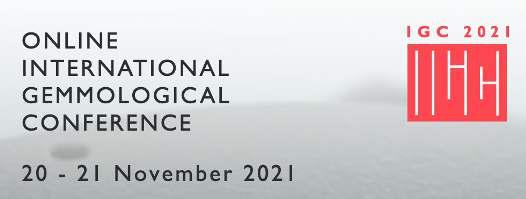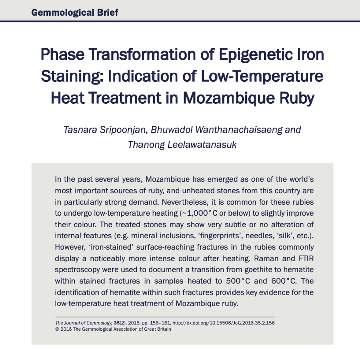
Possibilities and Challenges
Dr. Michael S. Krzemnicki
Director, Swiss Gemmological Institute SSEF
Photos and figures © M.S. Krzemnicki and SSEF, except where indicated otherwise



Dr. Michael S. Krzemnicki
Director, Swiss Gemmological Institute SSEF
Photos and figures © M.S. Krzemnicki and SSEF, except where indicated otherwise


approx.temperaturerangesasbygemmologicalliterature
• In most cases, heat treatment results in a change/shift of colour.
• The lower the heating temperature the more challenging is its detection!


Heat treatment at low temperatures mostly applied to remove bluish zones and slightly shift purplish sapphires to a pink colour. before after 2h heating (oxidizing) at 1000 °C





No magic “black box” for heat treatment detection !




Always a combination of ‘classic’ microscopy, UV reaction, and spectroscopic analyses (Infrared- and Raman spectroscopy).





’Classic’ heat treatment Low-temperature heat treatment
Atoll-structures (discoid extension features) and ”spotted” platelets are among those microscopic features indicating a heat treatment process. However, such characteristic features are often absent or very difficult to see, specifically in stones heated at lower temperatures (< 1000 °C)

UV Reaction





“chalky” whitish reaction under shortwave ultraviolet may indicate a heat treatment (at higher temperatures).
However, most heated corundum will not show such reaction (and even certain unheated stones may show similar whitish UV reactions!

Summarising: Classic detection methods Microscopy and UV reaction
• Microscopy remains to date very important for heat treatment detection.
• Obvious alterations of inclusions usually can be observed after heating at higher temperatures (beyond 1200 °C).
• In case of low-temperature heated stones, evident features for such treatment are often rather difficult to see or even absent.
• The same applies for stones which have no inclusions at all.









Infrared Spectroscopy (FTIR) of unheated and heated Corundum


SSEF press release in September 2018
However, not all corundum will show such characteristic peak series!


Nicolet iS50

Nicolet iS5






FTIR spectra of same heated ruby with different FTIR instruments! Effect



FTIR spectra of same heated pink sapphire in different orientations!
Summarising: Infrared analyses
• FTIR spectra are very important for heat treatment detection.
• Specifically in cases in which no microscopic heating feature is present (e.g. low-T heat treatment).
• There is quite a large consensus in the gemmological scientific community and between the laboratories about key features of FTIR spectra indicating heating in corundum.
• A main issue remains the impact of anisotropy (sample orientation) on FTIR spectra and differences in instrumental sensitivity.

Raman micro-spectroscopy is a powerful tool to analyse a gemstone and its inclusions. The laser beam focused through the microscope locally excites the molecules of the sample which results in a characteristic (vibrational) Raman spectrum of that sample/inclusion.

Scheme(slightlymodified)fromBonalesetal.2016



Zircon inclusions may provide important information about heat treatment (and origin) of corundum.

“Hot”pinksapphirefromIlakaka(Madagascar)containing many smallzirconinclusions.
Specifically useful for pink sapphires from Madagascar (Ilakaka).

Raman spectrum

Zhang etal.2000
Heating experiment of pink sapphire, Madagascar containing numerous tiny zircon inclusions!




In-house developed automated peak calculation (Dr Hao Wang).

Heated in oxidizing conditions at 1000° C for 1 hour (peak T).
Analysed before and after !
Peak position vs Peak width (FWHM) Diagrams




Peak position vs Peak width (FWHM) diagrams


Yellow spots: heated Pink spots: unheated




Krzemnicki et al. 2021
However, overlapping FWHM ranges of unheated and heated pink sapphires from Madagascar (Ilakaka) remain a challenge for heat treatment detection.

The influence of the geographic origin


Figures: Xu & Krzemnicki 2021
FWHM range criterion to detect heat treatment is not applicable for corundum from many important gem deposits (e.g. Myanmar, Kashmir, or Basaltic origin).

An additional approach: Phase transformations of hydroxides
Diaspore (α-AlOOH) and Goethite (α-FeOOH)

Transformation of goethite to hematite. from Koivula 2013
2 AlOOH Al2O3 + H2O 2 diaspore 1 corundum + water about 500°C
2 FeOOH Fe2O3 + H2O 2 goethite 1 hematite + water about 350°C

These are so-called dehydration reactions which occur when heating up these hydroxides (diaspore, goethite).

Heating stage Linkam TS 1200
- Coupled with Raman system for in-situ measurements


Step-wise heating, Tmax per step kept for 4 minutes only
Electric muffle furnace Nabotherm LHT 18
- Heating similar to gem trade

Step-wise heating, Tmax per step kept for 1 hour
Heating in air, step-by-step heating, Raman spectra only after cooling down


dotted vertical lines: main diaspore peaks

Sample 120993_6

Diaspore in Burmese ruby (Mogok)
Experiment setup: Linkam heating stage
Phase transformation

Diaspore in ruby (image width 2mm). before after dehydration

dotted vertical lines: main diaspore peaks
Sample 106424_21

Diaspore in Burmese sapphire (Mogok)
Experiment setup: Linkam heating stage
Phase transformation

Diaspore in fluid inclusion in sapphire (approx. 10 µm).


dotted vertical lines: main goethite peaks

Sample 85933_C3

Goethite in Mozambique ruby
Experiment setup:
Linkam heating stage
Phase transformation

Goethite in fissure in ruby



Raman spectroscopy of diaspore and goethite inclusions prove that the ruby and sapphire are unheated, although their infrared spectra is similar to heated corundum! Mozambique




Diaspore detected in fluid inclusion !
ref
ct
Sold at Sotheby’s auction in June 2023 for record $34.8 million.
from Sotheby’s International


Summarising: Raman analyses
• Raman spectroscopy on inclusions is a very promising tool to separate unheated corundum from low-temperature heated corundum.
• The zircon peak-width criterion (FWHM) is challenging (specifically to detect low-temperature heated corundum) and cannot be applied on corundum from certain (geologically young) gem deposits.
• However, the phase transformations of diaspore and goethite are key to separate unheated corundum from low-temperature heated stones.
• Our experiments confirm that diaspore and goethite transform (dehydrate) at about 325 °C (goethite to hematite) and about 550 °C (diaspore to corundum).
• The presence of diaspore and/or goethite is a clear indication, that a corundum is not heated, even in cases when FTIR may reveal peaks which could be (mis)interpreted as related to heating.

Summarising: Raman analyses

https://doi.org/10.3390/ min13121557

• Detection of low-temperature heating of corundum is challenging.
• The best is to use a combined approach (‘classic’ and spectroscopic methods), although microscopic features indicating heating may not be present.
• Infrared (FTIR) and Raman spectroscopy are key for separating unheated from heated stones.
• Scientific research in gemmology constantly evolves, actually parallel to the development of new treatment processes and the discovery of new deposits.
• Consequently, new findings may lead in certain cases also to new conclusions, similar to any other branch of science.
• Gemmological labs exchange their new findings about treatment detection, by - publication of results in scientific journals
- at gemmological conferences
- in gemmological working groups (e.g. LMHC)
- by inter-lab discussions
• By this we aim to harmonise results as much as possible and as such to support the gemstone trade and public with our expertise.

| Thank you for your attention Corroded calcite inclusions in an unheated Burmese ruby from Mogok.

